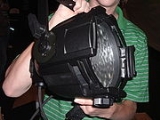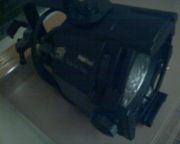
Source Four PAR
Encyclopedia
The Source Four PAR is a lighting fixture
manufactured by Electronic Theatre Controls
as a modern, energy efficient alternative to the traditional Parabolic aluminized reflector (PAR)
fixtures.
used in other ETC
Source Four
fixtures. The HPL lamp, combined with newer aluminum reflector technology, is designed to allow for more light output while using a lower wattage. The light output of a 575 watt HPL is listed as comparable to that of a 1000 watt PAR 64. The Source Four PAR can also be fitted with 375, 550, or 750 watt HPL lamps.
The fixture allows for beam and field adjustment using interchangeable lenses, and is designed for "shaping" the output (with the multifaceted lenses) in the same way that traditional PAR bulbs are inteded to be rotated inside a fixture for a more horizontal or vertical beam orientation. ETC manufactures five interchangeable glass lenses for this fixture (four come included, while the fifth, the XWFL, is a separate purchase.):
This interchangeability of the lenses is often considered an advantage, since traditional PAR fixtures require a stock of different lamps to achieve various beam angles. This allows for a great amount of flexibility from a single fixture.
The shortened barrel of a Source Four PAR (relative to a traditional PAR fixture) makes the light source more visible at a much greater angle. In some cases, this may be considered an unwelcome effect as it can cause lens flare or change the audience's perception of a theatrical scene. Top hats or Barn doors attach to Source Four PARs to eliminate this source visibility.
The Source Four PAR can be two or three times more expensive than traditional PAR cans, however replacement lamps are generally significantly less expensive than traditional PAR lamps, so the cost is considered to even out over time. Source Four PARs are also promoted as being "greener", in that HPL lamps use much less power to achieve the same light output. The HPL lamps are also significantly smaller than traditional PAR lamps (with the reflector and lens integrated into the lamp), and therefore less material is placed into landfills.
Source Four PAR fixtures have several parts, and in some environments (touring, rentals) require a greater measure of regular maintenance compared to traditional PAR cans. Nevertheless, industry professionals agree that the advantages of the fixture (flexibility, size, weight, light output, and cost-over-time) outweigh these considerations.
The Source Four PAR may have revolutionized fixture maintenance and inventory control in much the same way the Source Four Ellipsoidal Reflector Spot (ERS) did for the traditional spotlight, however many lighting designers argue that the fixture lacks the "raw" quality of light achieved by a traditional PAR can. Also, the distinct "oblong" shape of the beam of light from a traditional PAR lacks definition when used with a Source Four PAR's medium (MFL) or wide (WFL) flood lenses, and is completely non-existent when the very narrow (VNSP) or narrow (NSP) is utilized. Depending on the needs of the lighting designer, this could be considered a disadvantage.
Several major conventional theatrical lighting manufacturers have introduced different fixtures based on the Source Four PAR's design. Since the HPL lamp is proprietary to ETC, these imitation fixtures are often considered less efficient than the Source Four PAR.
 A variation of the Source Four PAR is the Source Four PARNel, a wash lighting fixture intended to be an alternative for Fresnel lantern
A variation of the Source Four PAR is the Source Four PARNel, a wash lighting fixture intended to be an alternative for Fresnel lantern
s. The name PARNel is a Portmanteau of PAR
and Fresnel
. The PARNel operates with 750-, 575- or 375-watt HPL lamps that are compatible with all other Source Four
fixtures. Unlike traditional Fresnel lanterns, where adjusting the light beam between flood and spot is accomplished by moving the lamp and reflector assembly relative to the lens, the PARNel is focused by rotating a stippled
lens. It can be focused from 25- to 47-degree field angles. The PARNel also uses the enhanced aluminum reflector technology, which theoretically allows a 575 watt lamp to output more light than a standard 1000 watt Fresnel lantern.
Stage lighting instrument
Stage lighting instruments are used in stage lighting to illuminate theatrical productions, concerts, and other performances taking place in live performance venues. They are also used to light television studios and sound stages.Many stagecraft terms vary between the United States and the United...
manufactured by Electronic Theatre Controls
Electronic Theatre Controls
Electronic Theatre Controls is a privately held corporation with global headquarters in Middleton, Wisconsin, United States. An international manufacturer of entertainment and architectural lighting systems, ETC offers professional lighting fixtures, lighting control consoles, dimming equipment...
as a modern, energy efficient alternative to the traditional Parabolic aluminized reflector (PAR)
Parabolic aluminized reflector light
A parabolic aluminized reflector lamp is a type of electric lamp that is widely used in commercial, residential, and transportation illumination. Usage includes locomotive headlamps, aircraft landing lights, and residential and commercial recessed lights...
fixtures.
Construction
The Source Four PAR is designed to use the same HPL lampLamp
Lamp is a light source, while LAMP is an acronym.-Lamps:Lamp may refer to one of the following:*Oil lamp, the original use of the term*Kerosene lamp, a lamp burning liquid petroleum...
used in other ETC
ETC
The abbreviation etc or ETC may stand for:* et cetera, a Latin expression meaning "and other things" or "and so on"In economics and finance:* Early Termination Chargers, a type of penalty chargers if break the contract...
Source Four
Source four
The Electronic Theatre Controls Source Four is an ellipsoidal reflector spotlight used in stage lighting. First released in 1992, the Source Four features an improved lamp and reflector compared to previous ERS designs, tool-free lamp adjustment, and a rotating, interchangeable shutter barrel...
fixtures. The HPL lamp, combined with newer aluminum reflector technology, is designed to allow for more light output while using a lower wattage. The light output of a 575 watt HPL is listed as comparable to that of a 1000 watt PAR 64. The Source Four PAR can also be fitted with 375, 550, or 750 watt HPL lamps.
The fixture allows for beam and field adjustment using interchangeable lenses, and is designed for "shaping" the output (with the multifaceted lenses) in the same way that traditional PAR bulbs are inteded to be rotated inside a fixture for a more horizontal or vertical beam orientation. ETC manufactures five interchangeable glass lenses for this fixture (four come included, while the fifth, the XWFL, is a separate purchase.):
| Lens | Abbreviation | Field Angle |
|---|---|---|
| Extra Wide Flood | XWFL | 60° |
| Wide Flood | WFL | 30° x 51° |
| Medium Flood | MFL | 21° x 34° |
| Narrow Spot | NSP | 19° |
| Very Narrow Spot | VNSP | 15° |
This interchangeability of the lenses is often considered an advantage, since traditional PAR fixtures require a stock of different lamps to achieve various beam angles. This allows for a great amount of flexibility from a single fixture.
The shortened barrel of a Source Four PAR (relative to a traditional PAR fixture) makes the light source more visible at a much greater angle. In some cases, this may be considered an unwelcome effect as it can cause lens flare or change the audience's perception of a theatrical scene. Top hats or Barn doors attach to Source Four PARs to eliminate this source visibility.
The Source Four PAR can be two or three times more expensive than traditional PAR cans, however replacement lamps are generally significantly less expensive than traditional PAR lamps, so the cost is considered to even out over time. Source Four PARs are also promoted as being "greener", in that HPL lamps use much less power to achieve the same light output. The HPL lamps are also significantly smaller than traditional PAR lamps (with the reflector and lens integrated into the lamp), and therefore less material is placed into landfills.
Source Four PAR fixtures have several parts, and in some environments (touring, rentals) require a greater measure of regular maintenance compared to traditional PAR cans. Nevertheless, industry professionals agree that the advantages of the fixture (flexibility, size, weight, light output, and cost-over-time) outweigh these considerations.
The Source Four PAR may have revolutionized fixture maintenance and inventory control in much the same way the Source Four Ellipsoidal Reflector Spot (ERS) did for the traditional spotlight, however many lighting designers argue that the fixture lacks the "raw" quality of light achieved by a traditional PAR can. Also, the distinct "oblong" shape of the beam of light from a traditional PAR lacks definition when used with a Source Four PAR's medium (MFL) or wide (WFL) flood lenses, and is completely non-existent when the very narrow (VNSP) or narrow (NSP) is utilized. Depending on the needs of the lighting designer, this could be considered a disadvantage.
Several major conventional theatrical lighting manufacturers have introduced different fixtures based on the Source Four PAR's design. Since the HPL lamp is proprietary to ETC, these imitation fixtures are often considered less efficient than the Source Four PAR.
Source Four PARNel

Fresnel lantern
A Fresnel lantern is a common lantern used in theatre, which employs a Fresnel lens to wash light over an area of the stage. The lens produces a wider, soft-edged beam of light, which is commonly used for back light and top light....
s. The name PARNel is a Portmanteau of PAR
Parabolic aluminized reflector light
A parabolic aluminized reflector lamp is a type of electric lamp that is widely used in commercial, residential, and transportation illumination. Usage includes locomotive headlamps, aircraft landing lights, and residential and commercial recessed lights...
and Fresnel
Fresnel lantern
A Fresnel lantern is a common lantern used in theatre, which employs a Fresnel lens to wash light over an area of the stage. The lens produces a wider, soft-edged beam of light, which is commonly used for back light and top light....
. The PARNel operates with 750-, 575- or 375-watt HPL lamps that are compatible with all other Source Four
Source four
The Electronic Theatre Controls Source Four is an ellipsoidal reflector spotlight used in stage lighting. First released in 1992, the Source Four features an improved lamp and reflector compared to previous ERS designs, tool-free lamp adjustment, and a rotating, interchangeable shutter barrel...
fixtures. Unlike traditional Fresnel lanterns, where adjusting the light beam between flood and spot is accomplished by moving the lamp and reflector assembly relative to the lens, the PARNel is focused by rotating a stippled
Stippling
Stippling is the creation of a pattern simulating varying degrees of solidity or shading by using small dots. Such a pattern may occur in nature and these effects are frequently emulated by artists.-Art:...
lens. It can be focused from 25- to 47-degree field angles. The PARNel also uses the enhanced aluminum reflector technology, which theoretically allows a 575 watt lamp to output more light than a standard 1000 watt Fresnel lantern.

